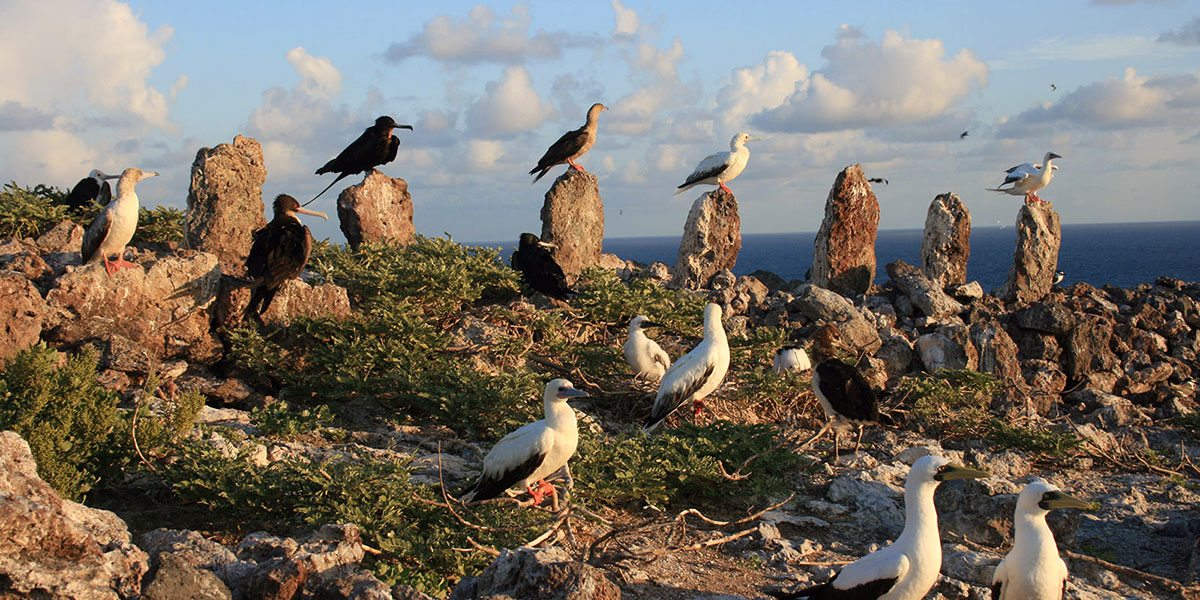News
Monumental Connections: Lectures and Talks

This is the fifth segment in a series of “Monumental Connections” to Papahānaumokuākea. Look for the next topic, “Get Involved.”

Hanauma Talks
Hanauma Talks is the YouTube and Google+ profile of the Hanauma Bay Education Program; an education program administered by Hawai'i Sea Grant and the City and County of Honolulu. Many are about Papahānaumokuākea Marine National Monument.
Image: Laysan albatross (left), black-footed albatross (center) and short-tailed albatross (right), face into the wind on Midway Atoll National Wildlife Refuge. Credit: Dan Clark/USFWS

Dr. Kekuewa Kikiloi - Bishop Museum (2013): The Archaeology of Nihoa and Necker Islands
Nihoa and Mokumanamana (Necker) Islands are part of the northwestern Hawaiian island chain. Both contain archeological remains. This “Traditions of the Pacific” lecture is entitled “The Archaeology of Nihoa and Necker Islands: towards a new understanding for Hawaiian pre-contact history.”
Image: Heiau (place of worship) at Mokumanamana. Credit: Kekuewa Kikiloi

Dr. Randy Kosaki - Maui Ocean Center Sea Talk Series: Coral Reef Research in Papahānaumokuākea Marine National Monument
Dr. Kosaki is a coral reef fish ecologist with NOAA's Papahānaumokuākea Marine National Monument. His research is primarily focused on the remote reefs of the Northwestern Hawaiian Islands, but has taken him to numerous localities across the tropical Pacific. Using helium/oxygen/nitrogen gas mixes and closed-circuit rebreathers, scientists are now probing the mesophotic coral ecosystems (deep coral reefs) of the NWHI. This so-called “coral reef twilight zone” is yielding high levels of unique Hawaiian species, as well as species that are completely new to science.
Image: This deep reef fish community at Kure Atoll is composed of 100% Hawaiian endemic species, the highest level of endemism known from any marine ecosystem on Earth. Credit: Richard Pyle/Bishop Museum

2015 Symposium Gives Audiences Rare Peek at Papahānaumokuākea
Image: Mokumanamana. Credit: Wayne Levin

2015 Papahānaumokuākea Symposium Opening & Keynote
Image: The birth of the Hawaiian Islands. Artwork by Solomon Enos

Papahānaumokuākea: Understanding of Place
Image: Researcher Patrick Springer evaluates the water conditions below the sheer cliffs of Nihoa. Credit: Shauna Kehaunani Springer

Utilizing Science and Culture to Manage Our Shorelines
Image: Researchers count ʻopihi along the rocky shorelines of Nihoa. Credit: Hoku Johnson/NOAA

Hōkūleʻa Worldwide Voyage Panel Discussion
Image: Hōkūleʻa sailing in front of Nihoa. Credit: Naʻalehu Anthony
Watch for the next topic: Get Involved.


